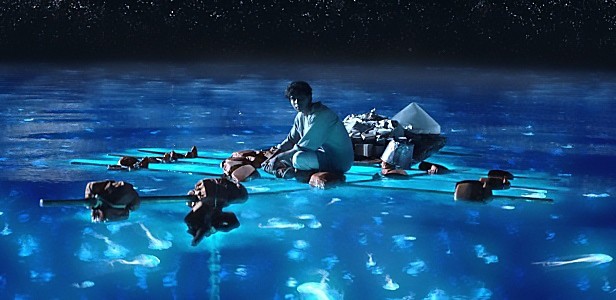The last time director Ang Lee made a tiger crouch, he walked away with about a dozen Oscar nominations, all from just one film. This time Lee goes all the way by unleashing the dragon – this is not just a beast of a movie, it is nothing short of a cinematic miracle in everything that it sets out to be.
Possibly the best adapted screenplay this year, LIFE OF PI remains true to its award winning source material by Yann Martel; at least for the most part. Just like the novel, the story plays out in three parts, starting with the introduction of Pi and how he was named after a swimming pool in France. Narrated by Irfan Khan as the older Pi, the story is set in 1970s Pondicherry, a former French colonial city in India. Born and raised a Hindu, Piscine Molitor Patel, the teenage protagonist and titular character dwells into the beliefs of Hinduism, Christianity and Islam, without claiming any one religion as superior. Pi’s father, a business minded zoo owner has other priorities like migrating to Canada, along with some of the exotic zoo animals for sale once they reach their destination. In a cruel twist of fate, the journey is short-lived soon after they sail into the Pacific Ocean on a cargo ship. Although tragic in nature, the sinking of the freighter, along with Pi’s parents and elder brother, is emotionally overwhelming yet visually spellbinding as the first of many sequences Lee and cinematographer Claudio Miranda has in store for the audience. What follows is a fierce and fascinating tale of survival when Pi finds himself in a lifeboat with an injured zebra, a merciless hyena, an orangutan and a fearsome but majestic Bengal tiger called Richard Parker.
Right from the opening credits, Lee and Miranda mesmerises us with one of the most incredible set pieces ever built for cinema. Forget what TV spots and teasers are calling this movie. Judging from what critics have to say, LIFE OF Pi is indeed an epic visualisation but not necessarily justifiable in its comparison to AVATAR. Apart from the novel use of 3D in both films, I personally can’t think of any other similarity. Lee’s use of 3D is not just immersive for the sake of being so; it becomes the skeletal binding to the pulsating flesh and blood of the story in such a way that I actually forgot about the 3D spectacles resting on the bridge of my nose!
Thanks to David Magee’s adaptation, Lee has made possible what acclaimed filmmakers have previously side-lined as impossible to film. From virtual humming birds hovering at arm’s reach, to the scene when we first meet Richard Parker, to embellishing the sheer beauty of creation, Lee has broken new ground in the way cinema interprets literature. No doubt there. However, Lee’s nuance as a storyteller is in bringing out the book’s underlying significance of subtly suggesting the existence of God, through a relentless test of faith. This is done by two actors: Suraj Sharma as the ship-wrecked younger Pi who exalts God even in the most trying situations. The other actor is of course Irfan Khan, whose retrospect narration to a writer proves the very existence of God. For a débutant, Sharma has a large chunk of screen-time and holds the story singlehandedly with some amusing interjections. On the other hand, khan has fewer scenes but skilfully advocates the phrase that less can prove to be more.
From where I’m seated, LIFE OF Pi has a sure fire lock-on for a few Oscar nominations. But the real reason this is a must-see film, preferably in 3D (I can’t stress this enough), is because there is every bit of passion in its making from surreal cinematography, a soul stirring original score, to spectacular visual effects, and a phenomenal narration that only ends when you hear an inner voice that says ‘Believe’.
Rating: 




